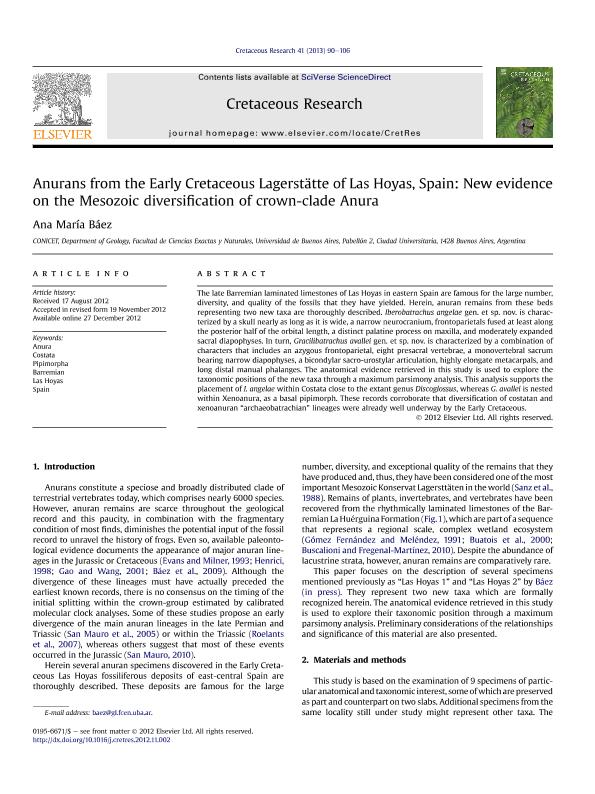Artículo
Anurans from the Early Cretaceous Lagerstätte of Las Hoyas, Spain: new evidence on the Mesozoic diversification of crown-clade Anura
Fecha de publicación:
04/2013
Editorial:
Elsevier
Revista:
Cretaceous Research
ISSN:
0195-6671
Idioma:
Inglés
Tipo de recurso:
Artículo publicado
Clasificación temática:
Resumen
The late Barremian laminated limestones of Las Hoyas in eastern Spain are famous for the large number, diversity, and quality of the fossils that they have yielded. Herein, anuran remains from these beds representing two new taxa are thoroughly described. Iberobatrachus angelae gen. et sp. nov. is characterized by a skull nearly as long as it is wide, a narrow neurocranium, frontoparietals fused at least along the posterior half of the orbital length, a distinct palatine process on maxilla, and moderately expanded sacral diapophyses. In turn, Gracilibatrachus avallei gen. et sp. nov. is characterized by a combination of characters that includes an azygous frontoparietal, eight presacral vertebrae, a monovertebral sacrum bearing narrow diapophyses, a bicondylar sacro-urostylar articulation, highly elongate metacarpals, and long distal manual phalanges. The anatomical evidence retrieved in this study is used to explore the taxonomic positions of the new taxa through a maximum parsimony analysis. This analysis supports the placement of I. angelae within Costata close to the extant genus Discoglossus, whereas G. avallei is nested within Xenoanura, as a basal pipimorph. These records corroborate that diversification of costatan and xenoanuran “archaeobatrachian” lineages were already well underway by the Early Cretaceous.
Palabras clave:
Anura
,
Costata
,
Pipimorpha
,
Barremian
,
Las Hoyas
,
Spain
Archivos asociados
Licencia
Identificadores
Colecciones
Articulos(OCA CIUDAD UNIVERSITARIA)
Articulos de OFICINA DE COORDINACION ADMINISTRATIVA CIUDAD UNIVERSITARIA
Articulos de OFICINA DE COORDINACION ADMINISTRATIVA CIUDAD UNIVERSITARIA
Citación
Baez, Ana Maria; Anurans from the Early Cretaceous Lagerstätte of Las Hoyas, Spain: new evidence on the Mesozoic diversification of crown-clade Anura; Elsevier; Cretaceous Research; 41; 4-2013; 90-106
Compartir
Altmétricas




